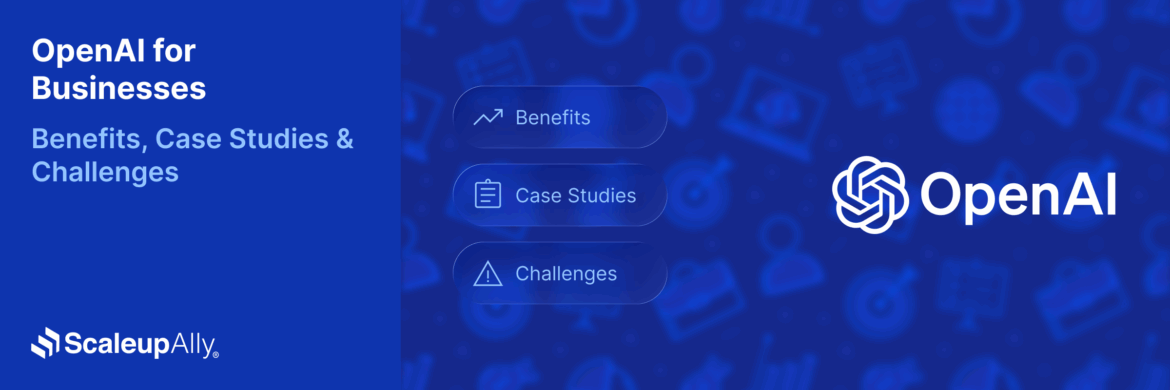
Best Use Cases of Generative AI in Banking & Finance
Manu Jain | February 29, 2024 , 11 min read
Table Of Content
Did you know that 77% of banking executives consider AI as the key to their success? More than half of industry leaders are already using AI to its fullest potential. In just three years, Generative AI is expected to lower costs by 9% and boost sales by 9%. Imagine the impact this could have on your bank!
Furthermore, 4 out of 10 people already use AI to manage their finances, and over half are open to using it if it helps with their financial concerns. Surprisingly, one-third of those who have used AI trust it more than a human to manage their money.
Forward-thinking companies like Morgan Stanley are already leveraging Generative AI in their internal chatbots. With OpenAI’s GPT-4, Morgan Stanley’s chatbot can now easily search through its wealth management content, simplifying access to vital information.
Are you ready to explore how Generative AI can revolutionize the future of banking? Keep reading to learn more about how it can transform your financial institution’s success.
Key Takeaways
- Generative AI enables banks to deliver highly personalized customer experiences based on transaction history and behavior.
- Fraud detection and prevention are enhanced as AI identifies unusual patterns and alerts banking teams instantly.
- AI-powered chatbots provide 24/7 support, handling customer queries and transactions efficiently and accurately.
- Risk management and compliance improve as AI analyzes market trends, customer data, and regulatory limits proactively.
- Automated credit decisions, dynamic pricing, and personalized financial advice help banks optimize operations and increase customer satisfaction.
What is Generative AI in Banking?
Generative AI in banking refers to the use of artificial intelligence techniques to create new and unique data, such as financial reports, customer profiles, or investment strategies.
A bank could use generative AI to create personalized investment portfolios for customers based on their risk tolerance and financial goals. This could help banks provide more tailored services to their clients and improve customer satisfaction.
Benefits of Using Generative AI in Banking
The banking industry can benefit greatly from Generative AI. It can lead to personalized customer experiences and improve fraud detection and prevention. Here are some key benefits of using gen AI in the banking sector:
1. Personalized Customer Experiences
Generative AI can analyze vast amounts of customer data to create personalized banking experiences. For example, imagine a customer, Sarah, who regularly uses her bank’s mobile app for transactions. Generative AI can analyze her transaction history and offer personalized financial tips or product recommendations tailored to her spending habits, such as suggesting a savings account with better interest rates based on her income and expenditure patterns.
2. Fraud Detection and Prevention
If a customer, John, typically uses his credit card for purchases within his city, but suddenly a large transaction is made overseas, Generative AI can detect this anomaly and alert the bank’s fraud prevention team to investigate further. Generative AI can enhance fraud detection by identifying unusual transaction patterns and flagging potentially fraudulent activities.
3. Automated Customer Support
Generative AI-powered chatbots can provide instant, 24/7 customer support, answering queries and providing assistance with transactions. If a customer needs to transfer funds between accounts outside of regular banking hours, she can chat with the AI-powered chatbot, which can guide her through the process step-by-step.
4. Risk Management
Generative AI can analyze market trends and customer behavior to help banks make informed decisions about risk management. There could be a sudden increase in loan defaults in a specific industry unknown to bankers. In such a case, Generative AI can alert the bank’s risk management team to adjust lending criteria accordingly to mitigate potential losses.
5. Enhanced Compliance
For customers who make a series of large transactions that exceed regulatory limits, Generative AI can flag these transactions for review by the bank’s compliance team. This assists banks in adhering to regulatory requirements by continuously monitoring transactions for compliance with laws and regulations.
Implementing such benefits requires a strong technology foundation. Explore how our BFSI IT Services & Solutions can support your banking infrastructure to integrate Gen AI effectively.
Generative AI Use Cases in Banking & Finance
Generative AI can be used in various scenarios, from credit decisions to customer support. Let’s take a look at a few of them:
1. Automated Credit Decisioning
Consider a small business owner, Sam, who applies for a business loan. Generative AI can quickly analyze Sam’s business financials and credit history to make an instant credit decision, speeding up the loan approval process. This streamlines the credit decision process by analyzing the customer’s credit history and financial data to determine creditworthiness.
2. Behavioral Biometrics for Security
Generative AI can enhance security by using behavioral biometrics to verify a customer’s identity. How this could work is a customer who accesses her bank account using a mobile app. Generative AI can analyze Mary’s unique behavioral patterns, such as how she holds her phone or types on the screen, to verify her identity and prevent unauthorized access.
3. Dynamic Pricing Models
Generative AI can optimize pricing strategies by analyzing market trends and customer behavior to set dynamic prices for banking products and services. For instance, consider a bank offering mortgage loans. Generative AI can analyze market conditions and customer data to adjust interest rates in real-time, ensuring competitive pricing and maximizing profitability.
How Can Generative AI Transform Banking?
Explore top use cases that enhance security, efficiency, and customer experience.

Challenges of Using Generative AI in Banking
Generative AI has several benefits but also presents challenges. Implementing it can be problematic for some. We’ve outlined a few challenges that you may encounter when implementing generative AI:
1. Bias in AI Algorithms
Generative AI algorithms can unintentionally incorporate biases present in the data used to train them. If historical loan data used to train an AI model contains biases against certain demographics, the AI may inadvertently make biased lending decisions, which could lead to discrimination and legal issues for the bank.
2. Integration with Existing Systems
Integrating Generative AI into existing banking systems can be challenging. A bank that wants to use Generative AI for customer service chatbots must ensure that the chatbots can seamlessly integrate with existing customer service platforms and workflows, which may require significant development effort.
3. Explainability and Transparency
Generative AI algorithms can be complex and difficult to understand, making it challenging for banks to explain AI-driven decisions to customers and regulators. Imagine a customer questioning why an AI algorithm denied their loan application. The bank must be able to explain the decision transparently and understandably.
Case Study: Generative AI in Banking & Finance Examples
A few financial institutions have taken a leap in implementing Generative AI in their core strategies. A few of such institutions are:
1. JPMorgan Chase
JPMorgan Chase, one of the largest banks in the United States, has been using Generative AI to improve its trading strategies. The bank’s AI research team developed a system called LOXM, which uses Generative AI to analyze market data and generate trading strategies. LOXM has successfully improved trading performance and reduced risk for the bank.
2. HSBC
HSBC, a multinational banking and financial services organization, has implemented Generative AI to enhance its anti-money laundering (AML) efforts. The bank uses Generative AI algorithms to analyze large volumes of transaction data and identify potentially suspicious activities. This has helped HSBC improve its AML detection capabilities and comply with regulatory requirements.
3. DBS Bank
DBS Bank, a leading bank in Asia, has adopted Generative AI to personalize customer experiences. The bank uses Generative AI algorithms to analyze customer data and provide personalized product recommendations and financial advice. This has led to increased customer satisfaction and loyalty for DBS Bank.
Conclusion
These are exciting times for the banking industry as generative AI promises a wide range of benefits along with some inherent risks and challenges. Financial institutions are actively working to minimize these risks and will need to reevaluate their governance frameworks and implement new controls for generative AI in the near future.
One of the risks associated with generative AI is algorithmic bias, which can occur due to flawed engineering decisions or inaccurate training data. Additionally, privacy concerns may arise due to the extensive use of personal or sensitive data during model training.
However, it’s essential to adopt a responsible, guided, and people-first approach from the outset to ensure sustainable scalability and growth.
If you’re in the banking sector and haven’t yet implemented generative AI, it’s time to consider doing so. AI is the future, and there’s no time to waste. We have extensive experience working with the banking and financial services industry.
If you’re interested in implementing generative AI into your financial product, let’s schedule a call to discuss how we can assist you with our tailored Gen AI services.
Frequently Asked Questions (FAQs)
Q: How is Generative AI used in trading and investment?
Generative AI is used in trading and investment to analyze market data and generate trading strategies. It can identify patterns in market trends and make predictions about future price movements. This helps traders and investors make more informed decisions and potentially increase their returns.
Q: How can banks ensure the ethical use of AI in banking and finance?
Banks can ensure the ethical use of Generative AI by implementing strict data privacy and security measures, ensuring compliance with regulatory requirements, regularly auditing AI algorithms for bias, providing transparency in AI-driven decisions, and seeking input from ethics experts and stakeholders.
Q: What role does Generative AI play in personalized banking experiences?
Generative AI enables banks to analyze customer data and behavior to offer personalized banking experiences. This includes customized product recommendations, tailored financial advice, and personalized offers based on individual customer needs and preferences.
Similar Articles Around Generative AI
Related Blogs

OpenAI for Businesses [Benefits, Use Cases & Challenges]
Discover the benefits of OpenAI for businesses. From reducing costs to scaling operations and enriching customer experiences. Real-world use cases included.
ScaleupAlly Team
Dec 16 ,
11 min read

Best 11 Agentic AI Tools in UAE: Accelerating Digital Transformation
Discover the top 11 agentic AI tools in UAE for 2025. Explore features, benefits, and tips to choose the right AI tool for your business growth.
Manu Jain
Nov 6 ,
9 min read

How to Choose an AI Development Company in Dubai: A Complete Guide
Find out how to choose the right AI development company in Dubai. Learn key factors, local considerations, and tips to select the best partner.
Manu Jain
Nov 6 ,
9 min read


